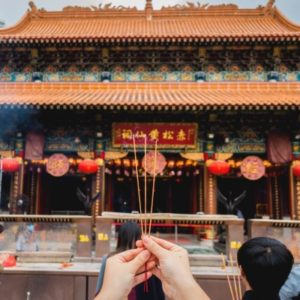 sparkling illuminations. Locals all around the city cherish and enjoy the spring festival, exchanging blessings and well wishes in the hopes of bringing good fortune in the following year. The Lunar New Year is more than just the beginning of a new calendar year; it is also a time of reunion and rebirth, signalling the end of winter and the start of spring. Hong Kong, which is home to a plethora of time-honoured customs, is sure to bring you luck!
sparkling illuminations. Locals all around the city cherish and enjoy the spring festival, exchanging blessings and well wishes in the hopes of bringing good fortune in the following year. The Lunar New Year is more than just the beginning of a new calendar year; it is also a time of reunion and rebirth, signalling the end of winter and the start of spring. Hong Kong, which is home to a plethora of time-honoured customs, is sure to bring you luck!
Following the Ox last year, the year 2022 has been declared as the Year of the Water Tiger. The tiger is the Chinese zodiac’s third animal and is known as the “King of Beasts.” The tiger is a symbol of bravery, wisdom, and strength in Chinese culture.
People clean and decorate their houses and offices, give and receive lai see (red) envelopes with lucky money, and prepare family banquets during the Lunar New Year in Hong Kong.
Visit temples and shop for worship items:
 People flock to temples such as Wong Tai Sin Temple, or Dai Sian, Hong Kong’s busiest temple, to pray for blessings as the Chinese New Year festivities begin. It is said that those who visit the temple first and make a gift to the gods by lighting the first incense sticks will be blessed the most!
People flock to temples such as Wong Tai Sin Temple, or Dai Sian, Hong Kong’s busiest temple, to pray for blessings as the Chinese New Year festivities begin. It is said that those who visit the temple first and make a gift to the gods by lighting the first incense sticks will be blessed the most!
This year, Wong Tai Sin Temple is hosting a special online event during which visitors can pray and send their wishes via their website.
Lion dancing and Lai see
One of the most prominent Lunar New Year traditions is the Lion dance. Because the Lion represents strength, knowledge, and superiority, people do lion dances to bring good fortune, wealth, and luck, as well as to ward off evil spirits. Master Kwok Man-Lung, martial arts expert, coach, and leader of Kwok’s Kung Fu & Dragon Lion Dance Team, will be performing lion dances throughout Hong Kong.
Festive food
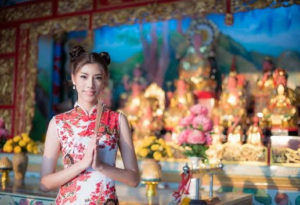 Delicious, substantial meals shared with friends and family are another significant part of the Chinese New Year celebration. Enjoy lucky foods like CNY puddings, which indicate growth, veggies, and fish, which represent prosperity and abundance. Only the middle half of the fish should be eaten, as it represents the beginning and finish of the year with a surplus. In addition to their excellent taste, traditional dishes served around the new year are supposed to bring favours.
Delicious, substantial meals shared with friends and family are another significant part of the Chinese New Year celebration. Enjoy lucky foods like CNY puddings, which indicate growth, veggies, and fish, which represent prosperity and abundance. Only the middle half of the fish should be eaten, as it represents the beginning and finish of the year with a surplus. In addition to their excellent taste, traditional dishes served around the new year are supposed to bring favours.
Poon Choi, a special dish from Chinese restaurants Dong Lai Shun and The Royal Garden, is an example of this.
“Poon Choi” is a popular auspicious food eaten during the Chinese New Year that is thought to bring abundance and wealth in the coming year. This Cantonese dish contains a variety of delectable ingredients, including pork, beef, chicken, duck, abalone, shrimp, dried 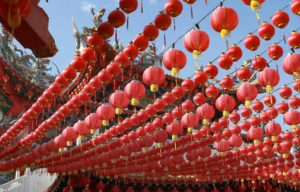 mushrooms, fishballs, squid, and vegetables.
mushrooms, fishballs, squid, and vegetables.
Dumplings, the most important course of the traditional Chinese New Year’s Eve feast. During the festival, families sit around the dinner table and wrap dumplings together. Dumplings are popular among the Chinese people due to their resemblance to ancient silver and gold ingots, which represent wealth. People say that the more dumplings you eat during New Year’s, the more money you’ll make the following year. They will also wrap a few dumplings with gold coins inside, and whoever receives the coin-dumpling is said to have good luck in the coming year.
Visit Chinese New Year flower markets:
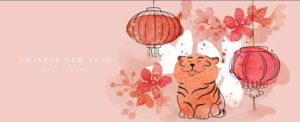 During the Chinese New Year period, one of the must-see attractions is the flower marketplaces. With colourful and fragrant floral displays, the market brings the festive spirit to life. The complete family traditionally goes to the flower market together to select auspicious plants and flowers for good luck, money, and prosperity. A stroll around the markets is thought to bring good fortune, as blooms represent prosperity in Chinese culture, and many flowers and fruits represent good fortune.
During the Chinese New Year period, one of the must-see attractions is the flower marketplaces. With colourful and fragrant floral displays, the market brings the festive spirit to life. The complete family traditionally goes to the flower market together to select auspicious plants and flowers for good luck, money, and prosperity. A stroll around the markets is thought to bring good fortune, as blooms represent prosperity in Chinese culture, and many flowers and fruits represent good fortune.
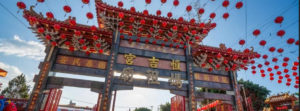 Make a wish at Lam Tsuen Wishing Trees
Make a wish at Lam Tsuen Wishing Trees
The Lam Tsuen Wishing Trees, located near the Tin Hau Temple, are a prominent Hong Kong shrine. One of Hong Kong’s most well-preserved traditions is the practice of praying for good fortune. People write their wishes on joss paper, tie it to an orange, and toss it into the branches of the tree. According to legend, if an orange is securely lodged in the tree’s branches without falling, a wish will be granted! (IANSlife)



